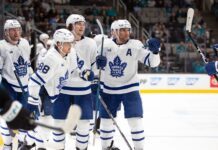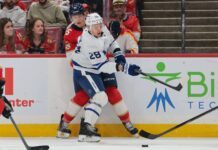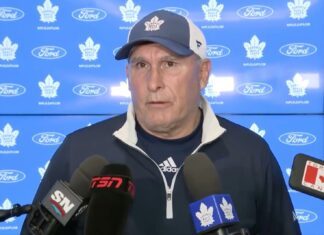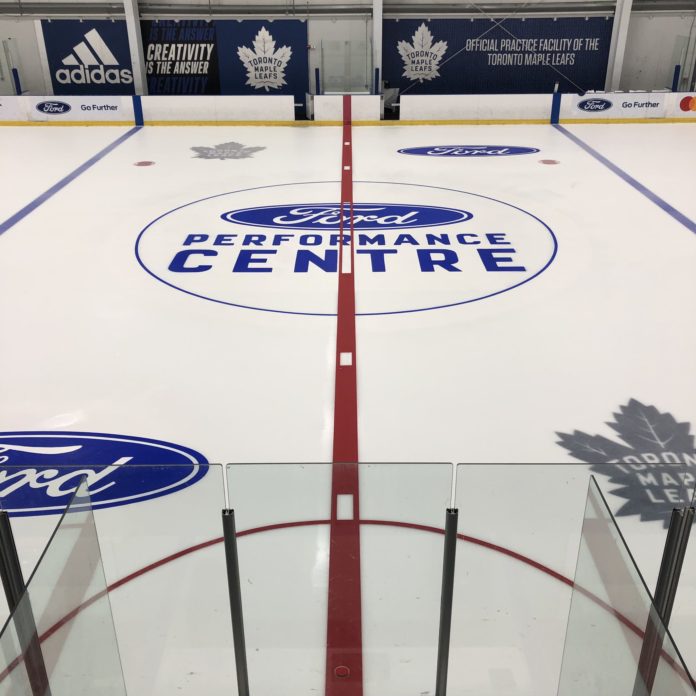
Sportsnet’s Elliotte Friedman provided an insightful radio hit on Friday, covering a number of topics concerning the Toronto Maple Leafs. We’ve got the key points covered with some thoughts below.
League shuts down Leafs’ current use of facilities over the offseason
Friedman: One of the things in the new CBA that was targeted at Toronto: They said you can’t open your facilities over the summer for guys. Toronto was a team where a number of their prospects would come to Toronto in the summer and work out at the practice facility and really improve as players. Teams were like, “We don’t like that. We think that is an advantage for Toronto, and we don’t want that to happen.” They shut that down.
Right on the heels of other clubs crying foul about the Leafs‘ use of referees during Phase 3 training camp, this is as bush league as it gets from the NHL to kowtow to these complaints — and it’s quite clearly myopic on the league’s behalf.
If more clubs, rather than whine to the league, were to make it a priority to make these kinds of resources available to their players and prospects in the offseason, the overall product on the ice would only improve over time. The Leafs‘ leadership in this regard should be encouraged, not ruled out of existence because some clubs don’t want to pay for staff and to keep the lights on in their facilities over the offseason.
The league is arguably in the best place it has ever been in terms of the quality of the on-ice product, and it’s been in large part driven by the waves of exciting, young, impact players breaking into the league. While some of the Leafs‘ local NHL players who summer in the area do take advantage of their facilities throughout the summer, it’s largely their interested prospects — who don’t have the means to hire their own professionals to handle their offseason training programs — that really benefit the most.
I can’t say it’s surprising, but it’s pathetic nonetheless.
This is the section relevant to #LeafsForever off-season camps, it's worth noting the language "even where Players may want to utilize such services".
It makes sense from the perspective of the PA, this way players will not feel pressured to do additional summer training. pic.twitter.com/jgn8K5arWT
— Earl Schwartz (@EarlSchwartz27) July 17, 2020
I cannot understand why other NHL teams would want to prevent off-season training, if not because they want to avoid paying for facilities and personnel.
Will be interesting to see if the Marlies still conduct sessions for Hoefenmayer, Brazeau, McKenna, Elyniuk, Sapego, etc
— Earl Schwartz (@EarlSchwartz27) July 17, 2020
Ilya Mikheyev’s next contract, the Leafs’ cap situation
Friedman: Mikheyev is one of the guys I don’t worry about as much because there is a lot of goodwill between him and the organization. When he got hurt that night in New Jersey, Dubas stayed with him when the team went back to Toronto, and stayed with him for a couple of days. Chris Johnston wrote a great story about how grateful Mikheyev was for the care the Maple Leafs showed in him after what could have been a pretty devastating injury.
The word coming out of it at the time then was not that it necessarily meant anything in terms of the actual dollars, but I think it would make it an easier path to get the next one done. He was grateful and appreciative and his agent was grateful and appreciative, and they would remember it.
The Maple Leafs have a lot of guys who have signed contracts and a lot of their cash has been paid early. You look at the AAVs of their contracts and the cash that still needs to be paid out is less or starts to decrease. One GM told me that he thought, if the Leafs had to make moves, they would be in a good position to be able to do it because teams will want higher cap hits than cash, and Toronto has a lot of situations where you could do that. I think that will help them in their ability to get different contracts done, like Mikheyev’s, too.
While many have fixated on the Leafs’ cap bind with the flat cap in place for 2020-21, we recently spoke in this space about not overlooking the competitive advantage of Leafs’ vast resources at a time when we may see a contraction of payroll from many teams around the league. This is a good example here from Friedman in terms of how the Leafs have used bonuses and front-loaded deals to increase their flexibility.
When it comes time to shuffle the deck in the offseason, the Leafs have paid out a player such as Kasperi Kapanen — who I use here as an example, not necessarily as an argument for their most likely trade piece — $5.4 million of his three-year, $9.6 million contract that was signed last offseason (we’re including his $1 signing million bonus for 2020-21). Kapanen carries a base salary of just $1.86 million for next season, and he is owed $2.34 million between his bonus and base salary in 2021-22.
With Andreas Johnsson, also including his 2020-21 signing bonus, the Leafs will have already paid him $6 million out of his four-year, $13.6 million contract signed last offseason. That means he’s owed an average of just $2.5 million per year in real salary over the final three seasons of his deal.
The story is very similar with Alex Kerfoot — the other mid-tier RFA the Leafs inked last offseason — as the Leafs will have already paid him $6 million on his four-year, $14 million contract. He’s owed just $2.6 million per year in real salary over the remaining three seasons of his deal after the Leafs pay his 2020-21 signing bonus.
In all three cases, in a league where the cap is freezing at $81.5 million for next season despite a significant revenue shortfall, it makes the assets more attractive as prime-aged, middle-six forwards capable of solid offensive production.
It will also help if the Leafs can indeed get a team-friendly deal inked on Ilya Mikheyev — one of only two RFAs of note this offseason, along with Travis Dermott — as Friedman indicates may well be in the making. His playoff performances may change the negotiation there, however; after so much time spent on the ice rehabbing during the pause, he’s received rave reviews of his performance in camp already.
Andreas Johnsson and the playoff roster
Friedman: I am not sure because I think what you have to do — I checked this yesterday — declare at the beginning. I am not sure Johnsson is going to be able to do it. The same thing in Columbus with Josh Anderson. He is another guy people thought was out for the year, and there is talk that Columbus might put him on the playoff roster. They’d have to burn a spot and there is no guarantee he is going to play.
If Toronto goes, it will go that route — putting him on the roster with no guarantee he’d play. I am not convinced at this point in time that he is going to be able to do it.
No doubt, coming off of major knee surgery, rehabbing, practicing, and then jumping into the playoffs mid-stream is definitely no easy chore. GM Kyle Dubas has already mentioned, though, that the Leafs are going to bring 28 or 29 players to the bubble — and they’re allowed 30 on the roster. They will almost certainly add Andreas Johnsson‘s name to the playoff list in case the team goes two, three, or four rounds deep.
Nick Robertson and the playoff roster
Friedman: They are sending a message by having him here. There is also the Russian kid, Barabanov, who signed, too. It is going to be interesting watching them find how they are going to manage the roster and find spots for all of these things.
I am a big believer in one thing: The players determine who plays. The thing about Robertson is, they very clearly wanted to reward him, but they also wanted to spend a message to everybody, too, that this guy is coming, and don’t assume he can’t take your job.
I heard Brian Burke say this week he thought it was crazy to insert Robertson now. I look at it like a lot these teams are trying to tell their guys that we don’t have time for anyone who has a slow start. These games are too meaningful right now.
By them including Robertson, it says to me they are big believers in him. He had a great year and they wanted to reward him for it. But he is on their radar. To me, it is kind of a warning to their guys that say, “If you are not ready, this kid is going to be ready, and he is going to take your job.”
The Leafs appear to be handling this the right way so far. They’ve brought Nick Robertson in as a reward for his outstanding OHL season and to ratchet up the competitiveness of the camp, but they are also making it hard on him to earn it; as it should be for any 18-year-old, he’s going to have to give the team no choice by making no doubt as to whether he’s among the top 12 forwards if he’s actually going to play.
It’s not like Robertson has been thrown onto a regular NHL line ahead of veterans; he’s been on a taxi-squad line with Adam Brooks and Egor Korshkov while receiving some power-play looks in place of Mitch Marner (when he has been taking reps on the PK team), and he is currently practicing in the reserve group today.
Leafs skating in a main group & reserve group today
Main group:
Nylander-Matthews-Hyman
Mikheyev-Tavares-Marner
Engvall-Kerfoot-Kapanen
Clifford- 🐐-SpezzaRielly-Ceci
Muzzin-Holl
Dermott-Barrie
Marincin-SandinAndersen
Campbell— Mark Masters (@markhmasters) July 17, 2020
While the head coach is clearly a huge fan of Robertson’s professionalism and skill set, the reviews from Sheldon Keefe of Robertson’s play in camp so far have been lukewarm; they’re not handing him anything, nor should they.



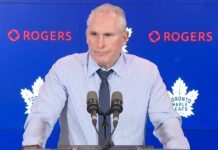








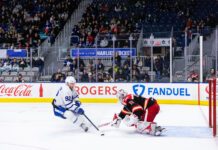


![John Gruden after the Leafs prospects’ 4-1 win over Montreal: “[Vyacheslav Peksa] looked really comfortable in the net… We wouldn’t have won without him” John Gruden, head coach of the Toronto Marlies](https://mapleleafshotstove.com/wp-content/uploads/2025/09/gruden-post-game-sep-14-218x150.jpg)



